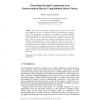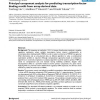16 search results - page 1 / 4 » Extracting Principal Components from Pseudo-random Data by U... |
KES
2010
Springer
13 years 3 months ago
2010
Springer
We develop a methodology to grasp temporal trend in a stock market that changes year to year, or sometimes within a year depending on numerous factors. For this purpose, we employ ...
BMCBI
2005
13 years 5 months ago
2005
Background: The responses to interleukin 1 (IL-1) in human chondrocytes constitute a complex regulatory mechanism, where multiple transcription factors interact combinatorially to...
CVPR
2008
IEEE
14 years 7 months ago
2008
IEEE
Parameterized Appearance Models (PAMs) (e.g. eigentracking, active appearance models, morphable models) use Principal Component Analysis (PCA) to model the shape and appearance of...
WSCG
2004
13 years 6 months ago
2004
Principal Component Analysis (PCA) is a basis transformation to diagonalize an estimate of the covariance matrix of input data and, the new coordinates in the Eigenvector basis ar...
TNN
1998
13 years 4 months ago
1998
— This paper introduces a new system for real-time detection and classification of arbitrarily scattered surface-laid mines from multispectral imagery data of a minefield. The ...


